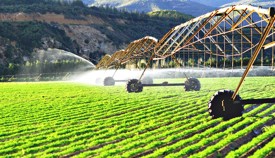The United Nations estimates that farmers will need to grow 70% more food to feed the population by 2050 while available fresh water resources will continue to shrink. Faced with multiple challenges related to water availability including drought and decreasing groundwater, here are five growing trends in farm irrigation.

Biotech companies are using advanced genomics to create seeds for crops that need less water and are more tolerant of drought conditions. For example, drought resistant crops may have deeper roots or stomata that close sooner to hold more moisture. Although results can be mixed, it is one way farmers can deal with the costly multi-year drought in the Southwest United States and the expected increase in droughts in the future.
2. Drip Irrigation
Drip irrigation allows for precise control of the application of water and fertilizer, which can greatly reduce the amount of water needed for crop irrigation. Although it can cost up to $1 million to install, many farmers are seeing the appeal of saving water which can be used to plant more crops or reduce costs. As of 2010, 43% of California farmland still used some form of gravity irrigation but this is down from 70% in 1991.
3. Measuring Water Flow
Precise measurement of water usage with water flowmeters can prevent overwatering and reduce costs for farmers. As water resources become more limited and expensive it will be more important to have accurate data on how much water is being used to irrigate. Additionally, soil sensors can track soil moisture to determine how much water should be used and allow farmers to make water-saving adjustments.
4. Data Analytics
New software products that crunch large amounts of data can provide farmers with important information that they previously didn’t have access to. Using data such as local weather as well as data collected from their equipment, farmers can receive recommendations and better understand how much water is needed to optimize production while minimizing water waste.
5. Drilling More Wells
Farmers are relying more on groundwater sources for irrigation and as the water table falls due to unsustainable levels of pumping, farmers need deeper wells to continue tapping local groundwater sources. In California’s Central Valley the drilling contractors are so busy that the waiting time can be six months to install a new well at a cost of around $100,000. Some farmers are even buying their own drilling equipment to drill their own wells.
